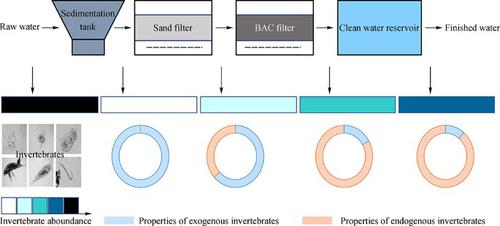Frontiers of Environmental Science & Engineering ( IF 6.4 ) Pub Date : 2020-10-10 , DOI: 10.1007/s11783-020-1354-6 Zhiling Wu , Xianchun Tang , Hongbin Chen

|
Problems associated with excessive propagation and leakage of invertebrates in drinking water have received increasing attention in recent years. We performed a monthly survey of invertebrate abundance and taxa in the effluent of each treatment stage in a drinking water treatment plant between May 2015 and April 2016 and analyzed seasonal and treatment-process variations in invertebrates. The results showed that invertebrate abundances in raw water, effluent of the biological activated carbon (BAC) filter, and finished water significantly correlated with water temperature, whereas no correlation was observed between water temperature and invertebrate abundance in the effluents of the sedimentation tank and sand filter. The dominant taxa in the effluent of each treatment stage were rotifers, nematodes, and crustaceans. The sedimentation tank could efficiently remove invertebrates with an annual average removal rate of 92%. The propagation and leakage of invertebrates occurred in the sand and BAC filters but more seriously in the latter. The average reproduction rate in the BAC filter was 268.8% with rotifers as the taxon that leaked the most. Invertebrate survival and reproduction were also observed in the chlorine-disinfected clean water reservoir with an average reproduction rate of 41.9%. Owing to differences in chlorine resistance, the reproduction ability of the dominant taxa was in the order nematodes>crustaceans>rotifers. The proportion of endogenous invertebrates gradually increased along the treatment process. The average proportion of endogenous invertebrates in the finished water was higher than 79.0%. Our findings suggested that waterworks should pay more attention to endogenous invertebrate growth.
中文翻译:

饮用水处理厂无脊椎动物的季节性和处理过程变化
近年来,与无脊椎动物过度繁殖和泄漏有关的问题越来越受到关注。我们在2015年5月至2016年4月之间对饮用水处理厂每个处理阶段的出水量进行了无脊椎动物丰富度和分类单元的每月调查,并分析了无脊椎动物的季节性和处理过程变化。结果表明,原水,生物活性炭(BAC)过滤器的出水和最终水中的无脊椎动物丰度与水温显着相关,而沉淀池和沙子中的出水温度与无脊椎动物丰度之间没有相关性。过滤。每个处理阶段出水中的主要分类单元是轮虫,线虫和甲壳类。沉淀池可有效去除无脊椎动物,年平均去除率达92%。无脊椎动物的繁殖和渗漏发生在沙子和BAC过滤器中,但在后者中更为严重。BAC过滤器的平均繁殖率为268.8%,其中轮虫为泄漏最多的分类单元。在氯消毒的净水水库中也观察到无脊椎动物的生存和繁殖,平均繁殖率为41.9%。由于耐氯性的差异,优势类群的繁殖能力为线虫>甲壳类>轮虫。内源性无脊椎动物的比例在治疗过程中逐渐增加。最终水中内生无脊椎动物的平均比例高于79.0%。

























 京公网安备 11010802027423号
京公网安备 11010802027423号